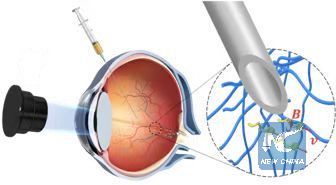
Slippery nanorobots penetrate an eye by Mar Planck
WASHINGTON, Nov. 2 (Xinhua) -- German, Chinese and Danish scientists developed a nanometer-sized robot that can, for the first time, drill through eyeballs without damaging them, with a potential to be used as a minimally-invasive tool for precisely delivering drugs.
The study, published on Friday in the journal Science Advances, described the propeller-shaped vehicle, 200 times smaller than the diameter of a human hair and even smaller than a bacterium's width.
With a slippery coating, the robot can move unhindered through the dense tissue in the eye, according to the study.
"We applied a liquid layer found on the carnivorous pitcher plant, which has a slippery surface on the peristome to catch insects," said the study's first author Wu Zhiguang at the Germany-based Max Planck Institute for Intelligent Systems.
"It is like the Teflon coating of a frying pan. This slippery coating is crucial for the efficient propulsion of our robots inside the eye, as it minimizes the adhesion between the biological protein network in the vitreous and the surface of our nano-robots," said Wu.
The researchers tested their nano-propellers in a dissected pig's eye. They injected tens of thousands of their bacteria-sized helical robots into the vitreous humor of the eye.
With the help of a surrounding magnetic field that rotates the nano-propellers, they then swim toward the retina.
"We want to be able to use our nano-propellers as tools in the minimally-invasive treatment of all kinds of diseases, where the problematic area is hard to reach and surrounded by dense tissue," Max Planck researcher Qiu Tian, one of the corresponding authors of the study, told Xinhua.
The University of Stuttgart, the Max Planck Institute for Medical Research in Heidelberg, the Harbin Institute of Technology in China, Aarhus University in Denmark and the Eye Hospital of the University of Tubingen contributed to this work.

